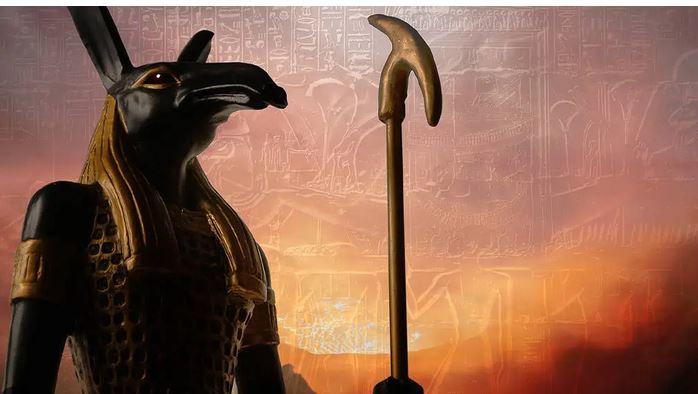Ägyptischer Seth

In Egyptian mythology, Seth (also spelled Set or Setekh) is a significant and complex deity who is often associated with chaos, disorder, storms, violence, and conflict. Despite his negative traits, Seth also plays a crucial role in the balance of the cosmic order. His mythological narrative, particularly his rivalry with his brother Osiris, is central to many Egyptian myths.
Key Aspects of Seth in Egyptian Mythology:
Role and attributes:
Seth is typically depicted as a god of chaos, associated with the desert, storms, and the uncontrollable forces of nature. He is the personification of disorder and the opposite of Osiris, the god of life, fertility, and order. Seth represents destruction, storms, and the forces that threaten harmony in the world, including war and violence.
He is often shown with the head of an animal known as the Set animal, which resembles a mixture of a donkey, aardvark, or perhaps an unknown creature. The Set animal's exact identity remains unclear, but it symbolizes the chaotic and foreign nature of Seth.
Seth and His Family:
Seth is the son of the earth god Geb and the sky goddess Nut, making him a member of the Ennead of Heliopolis (a group of nine major deities in Egyptian mythology). His siblings include Osiris, Isis, Nephthys, and Horus.
Seth's relationship with his family is marked by conflict, especially with Osiris and his son Horus.
The Murder of Osiris:
One of the most famous myths involving Seth is his murder of Osiris. According to the myth, Seth was envious of his brother Osiris, who was beloved by the people and ruled as king of Egypt. Seth, seeking to take the throne, tricked Osiris into lying in a beautifully crafted coffin, which he then sealed and threw into the Nile River, where it was carried away and eventually lodged in a tree.
Isis, Osiris's wife, searched for and found his body. After mourning his death, she miraculously conceived her son Horus. The myth then shifts to Horus’s eventual struggle to avenge his father’s death by defeating Seth.
The Struggle with Horus:
Seth's rivalry with Horus, the son of Osiris and Isis, is another central aspect of his myth. After Osiris's death, Horus sought to avenge his father and reclaim the throne of Egypt from Seth. The two gods engaged in a fierce battle, which lasted for years, involving many challenges and trials. In the end, Horus was victorious, and Seth was either killed or exiled, depending on the version of the myth.
Horus's victory symbolizes the triumph of order (ma'at) over chaos, with Seth representing the forces of disorder and destruction.
Seth's Ambiguous Nature:
While Seth is often portrayed as a villain in myths, his role is more nuanced. He is also a protector of the sun god Ra, particularly during Ra's nightly journey through the underworld. In this capacity, Seth fights off the serpent Apophis, which represents chaos and threatens Ra's journey. This role suggests that Seth, despite being a god of chaos, can also serve the larger cosmic order, showing that chaos is a necessary force in the universe to maintain balance.
Seth is sometimes seen as the god of the desert and foreign lands, contrasting with the fertility and order of the Nile River valley. In this sense, he represents the untamed, uncontrollable forces of nature that are outside the realm of civilization.
Seth and the Pharaoh:
In later periods of Egyptian history, Seth was also associated with kingship. Some pharaohs, particularly from the Second Intermediate Period (especially those of the Hyksos dynasty), adopted Seth as a patron deity. This association with the Hyksos, who were seen as foreign rulers, further emphasizes Seth's connection to the desert and foreign lands.
However, in most periods, Seth was still viewed with ambivalence, as his role in the mythological stories of Osiris and Horus made him a symbol of disruption and chaos, which was at odds with the ideal of the pharaoh as the upholder of cosmic order.
Seth's Worship and Legacy:
Seth was worshiped primarily in the Delta region and at the city of Oasis, where he had a prominent temple. His worship declined significantly after the New Kingdom period when he became associated with the chaotic and violent forces of nature. However, his presence remained significant in the Egyptian pantheon as a complex deity who embodied both destruction and preservation.
In summary:
Seth is a multifaceted and often contradictory deity in Egyptian mythology. He represents chaos, storms, and violence but also plays a protective role in the cosmic order, particularly in defending the sun god Ra from the forces of evil. Seth's most famous myth involves his murder of his brother Osiris, a tale that sets the stage for the rivalry between Seth and Horus, which symbolizes the struggle between chaos and order. Though often viewed as an antagonist,
Seth is ultimately a necessary force in the balance of the universe.